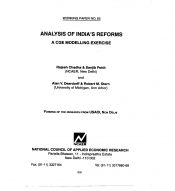Analysis of India's Reforms: A CGE Modelling Exercise
Sanjib Pohit
Rajesh Chadha
Alan V. Deardorff
Robert M. Stern
April 1997
The process of major economic reforms undertaken in the Indian economy has completed nearly five years of implementation. The economy has entered into a new phase of development directed towards becoming globally competitive through the opening of trade, foreign investment, and technology inflows. The unilateral reform measures in the industrial and the trade policies of India along with reforms in the tax-regime represent a significant departure from the policy framework of the past four decades and are important to the future course of the Indian economy.
The basic objective of this working paper is to evaluate the comparative static effects of selected trade and domestic policy reforms on trade, output, domestic prices, economic welfare and intersectoral allocation of resources. The major reforms analyzed in this study relate to reduction in tariff and non-tariff barriers to trade along with rationalization of the tax-regime. A computable general equilibrium (CGE) model of the Indian economy has been constructed for the purpose of analysis.
National Growth and Macroeconomic Centre







